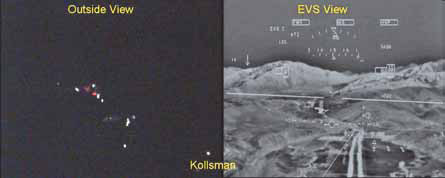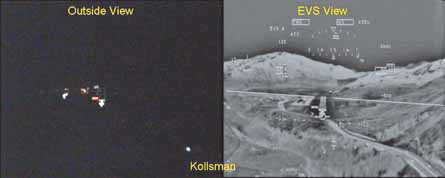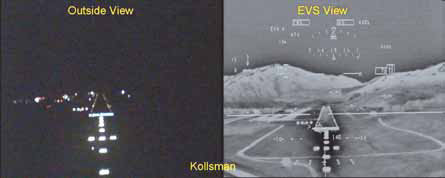Pending European approval to use enhanced vision systems will clear the way for much wider use of infrared sensors for low-visibility approaches
Infrared sensors have helped the military fly at night and find targets for decades, and now the civil market is expanding as the benefits of enhanced vision in low visibility become more widely appreciated. Whether for improved situational awareness or lower approach minima, infrared enhanced vision systems (EVS) are growing in popularity within business aviation and could be about to catch on with commercial airlines.
First certificated in 2001, EVS deliveries now exceed 600 units across business and general aviation, and US package carrier FedEx Express has embarked on a programme to equip its entire fleet of freighters. Pending regulatory changes in Europe and the USA promise to open the market even further, with proponents of enhanced vision believing the technology is destined to become ubiquitous.
The signs are promising. Gulfstream, working with sensor supplier Kollsman and head-up display (HUD) manufacturer Honeywell, certificated the first EVS in September 2001, and so far more than 260 of its large business jets have been equipped with the system. Gulfstream and Kollsman are working on a second-generation system, EVS II, and the same sensor is used in FedEx's HUD/EVS, with both applications due for certification next year.
Bombardier, working with sensor supplier CMC Electronics and HUD manufacturer Thales, certificated its EVS in the Global business jet family in mid-2005 and almost 40 aircraft have been equipped. Dassault is flight testing an EVS for its Falcon family, using the CMC sensor and Rockwell Collins head-up display, and Boeing Business Jets is in negotiations to use the same HUD/EVS combination.
 |
|---|
 |
 |
Aspen approach shows the terrain awareness and approach guidance benefits of Kollsman's EVS II |
Kollsman has delivered more than 300 EVS sensors, says Roy Gentry, vice-president commercial aviation systems, and has orders for 150 EVS IIs from Gulfstream and more than 260 from FedEx. The company has begun offering its system for retrofit on other aircraft types, and has more than 50 orders, he says. CMC, meanwhile, has delivered more than 100 EVS sensors.
Development of EVS has been as much about regulatory as technology advances, and the next step is about to take place with European approval of an operating rule reducing approach visibility minima by one-third for aircraft with a certificated HUD/EVS. The European regulation, expected early next year, is similar to the US Federal Aviation Administration's landmark "enhanced flight vision" (EFVS) rule, but will apply to commercial aviation, opening the door to airline use.
Published in January 2004, the FAA's EFVS rule lowered the minimum visibility for a straight-in instrument approach with a HUD/EVS-equipped aircraft. On reaching the 200ft (61m) decision height, if the runway environment is visible in the head-up sensor image, the pilot can continue the approach down to 100ft.
This operational benefit is only usable by private operators, however, as commercial carriers cannot begin an approach unless the reported visibility is equal to or greater than that published for the approach, says Les Smith, manager of the FAA flight operations branch. But Europe does not make a distinction between the two types of operator, and its rule will apply equally to business jets and commercial airliners.
The FAA's plans to harmonise with its European counterpart will, for the first time, make the HUD/EVS approach credit available to US airlines. "We will propose the same rule as Europe: if you have EFVS you will be able to reduce the required visibility by a third," says Smith. Industry sees this as a first step towards the use of EVS for zero-visibility landings. "I am not sure we will ever get to the point where it is zero-zero, but we would like to see EFVS used for landings," says Smith. EFVS operations all the way to touchdown, in lieu of lighting infrastructure requirements and in lieu of surface movement guidance control systems for low-visibility taxiing, are all on the roadmap.
It is not quite as simple as it sounds. Operational credit requires a certificated system and there are, as yet, no airworthiness standards for HUD or EVS. Instead, each aircraft manufacturer or aftermarket modifier must demonstrate the system performs its intended function through a proprietary type certificate or supplemental type certificate (STC) process that can involve flying hundreds of approaches.
Dassault is the first to go through this process with the European authorities, which are less familiar with EVS than their US counterparts, and flight testing is continuing. As a result, the immediate beneficiaries of the new European rule are likely to be operators of US-registered aircraft with an FAA-certificated HUD/EVS. Efforts are under way to draw up airworthiness standards and make certification easier.
Case-by-case
"Today it's case-by-case," says Smith. "The EFVS rule defines equipage - HUD plus a sensor - but it does not define sensor performance. It says you have to have a system certificated by the FAA, and EASA [the European Aviation Safety Agency] will do the same." The FAA has asked advisory body RTCA to form a new committee to recommend minimum operational standards for EVS, for use in certification.
|
|---|
Gulfstream mounts its EVS sensor under the nose |
In the USA, meanwhile, FedEx decided to move ahead with EVS despite the lack of operational credit because of the safety benefits. The carrier has completed flight testing on a Boeing MD-10 freighter, and will begin certification tests next year. The system comprises a Kollsman EVS II sensor mounted on the top left-hand side of the radome and a liquid-crystal display HUD developed by Honeywell and Kollsman.
FedEx decided to fit HUDs because of the operational benefits, and added EVS for the safety enhancement, but the carrier is working with the FAA on ways to use the combination to improve operations. Taking off in reduced visibility is one area. Private operators can use EVS for taxi and take-off, but get no operational credit, says Smith. "We have a proof-of-concept trial with FedEx to use their certificated system to lower visibility minimums on take-off," he says. HUD/EVS would be used in lieu of runway centreline lights for take-off down to 500ft runway visual range (RVR).
It is clear the EVS market is entering a new phase as technology matures. Kollsman's second-generation system is smaller and lighter and uses an improved infrared detector with three times the sensitivity. "EVS II has been flying for over a year, and is more than 30% better than EVS I," says Gentry. While the original sensor provides consistent performance in 1,200ft RVR or lower, with EVS II "we are down to less than 900ft RVR", he says.
Cooled sensors
The cryogenically cooled infrared sensors used in certificated HUD/EVS applications represent the expensive end of the market, typically costing around $500,000. The fastest growing sector is at the lower end, where uncooled-infrared enhanced vision systems are available for less than $15,000.
Uncooled EVS uses a different infrared sensor technology (see box) and so far has been approved for head-down situational awareness only. But the perceived safety benefits are substantial, and uncooled EVS market leader Max-Viz has sold more than 270 systems, with STCs on around 50 different fixed- and rotary-wing aircraft. Max-Viz offers single- and dual-band systems and has developed a triple-sensor EVS to handle new airport lighting.
The past 12 months has seen other manufacturers move into the uncooled EVS market, offering lower-cost systems. "We are seeing more competition, which we view as validating the market," says Max-Viz president and chief executive Jim Tuttle. Forward.Vision and L-3 Avionics Systems are offering low-cost EVS sensors for general aviation that use infrared technology from the automotive industry. Max-Viz shareholder FLIR Systems has moved to protect the lower end of the market by offering its own low-cost EVS using the infrared sensor in BMW's night-vision system.
It remains to be seen which direction the market will take. Tuttle says Max-Viz is working with an aircraft manufacturer to certificate a HUD/EVS using its uncooled system. This could put price pressure on cooled systems. Meanwhile, established EVS manufacturers are diversifying, with CMC's M-series and Kollsman's GAViS uncooled microbolometer sensors set to be approved by year-end.
Manufacturers and regulators are also starting to get to grips with the combination of enhanced and synthetic vision systems, which would merge real-world and computer-generated imagery to overcome the drawbacks of sensors and databases and allow aircraft to operate as safely in low visibility as they can in bright daylight.
Source: Flight International














